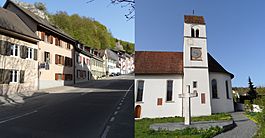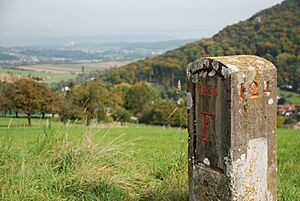Hofstetten-Flüh facts for kids
Quick facts for kids
Hofstetten-Flüh
|
||
|---|---|---|

Street in Flüh and church of Hofstetten
|
||
|
||
| Country | Switzerland | |
| Canton | Solothurn | |
| District | Dorneck | |
| Area | ||
| • Total | 7.51 km2 (2.90 sq mi) | |
| Elevation | 462 m (1,516 ft) | |
| Population
(Dec 2020 )
|
||
| • Total | 3,206 | |
| • Density | 426.9/km2 (1,105.7/sq mi) | |
| Postal code |
4114 (Hofstetten) & 4112 (Flüh)
|
|
| Surrounded by | Bättwil, Blauen (BL), Ettingen (BL), Leymen (FR-68), Metzerlen-Mariastein, Witterswil | |
Hofstetten-Flüh (called Hufstette-Flüe in Swiss German) is a town in Switzerland. It's located in the Dorneck district, within the Solothurn canton. This municipality is actually made up of two villages: Hofstetten and Flüh.
Contents
A Look Back in Time: Hofstetten-Flüh's History
Hofstetten-Flüh was first written about in the year 1194. Back then, it was known as Huhostetten.
Exploring the Geography of Hofstetten-Flüh
Hofstetten-Flüh covers an area of about 7.52 square kilometers (2.9 square miles). A large part of this land is covered by forests, making up about 44.7%.
About 40.4% of the area is used for farming. This includes fields for crops, pastures for animals, and areas for fruit trees. Around 14.8% of the land is built up with buildings and roads.
The municipality is found in the Dorneck district. It sits among hills, south of the Leimen valley. Hofstetten-Flüh is a special part of the Solothurn canton because it's an exclave. This means it's a piece of land that belongs to Solothurn but is separated from the main part of the canton by other areas.
Understanding the Coat of Arms
The coat of arms for Hofstetten-Flüh has a special design. It features a silver background with two red vertical stripes. At the top, there's a red section with a silver star. This unique design helps represent the municipality.
People and Population in Hofstetten-Flüh
Hofstetten-Flüh has a population of about 3,300 people. Around 13.2% of the people living here are from other countries. Over the past ten years, the population has grown by about 10.7%.
Most people in Hofstetten-Flüh speak German. About 92.1% of the population uses German as their main language. English is the second most common language, spoken by about 2.1% of residents. French is third, spoken by about 1.4%.
In terms of age, about 7.8% of the population are young children (0-6 years old). Teenagers (7-19 years old) make up about 17.7%. Adults aged 25 to 44 years old are the largest group, making up about 30.1% of the population.
Economy and Work in Hofstetten-Flüh
In 2010, the unemployment rate in Hofstetten-Flüh was 2.3%. This means a small number of people who wanted to work were looking for jobs.
Many people in Hofstetten-Flüh work in different areas. About 40 people work in farming and related businesses. Around 250 people work in manufacturing and construction. This includes jobs like making products or building things.
The largest number of people, about 262, work in the service sector. This includes jobs in shops, hotels, restaurants, and healthcare. Many people who live in Hofstetten-Flüh travel to other towns for work.
Religion in Hofstetten-Flüh
Based on information from 2000, many people in Hofstetten-Flüh follow different religions. About 41.9% of the population are Roman Catholic. Another 27.7% belong to the Swiss Reformed Church.
A smaller number of people follow other Christian churches, Islam, Buddhism, or Hinduism. About 22% of the population do not belong to any church or are agnostic or atheist.
Education and Schools in Hofstetten-Flüh
Education is important in Hofstetten-Flüh. About 40.6% of the population have finished high school. Also, 18.4% have gone on to get higher education from a university or a specialized college.
In the 2010-2011 school year, there were 224 students in the Hofstetten-Flüh school system. Children can attend two years of non-required kindergarten. There were 56 children in kindergarten during that year.
Students then attend six years of primary school. In Hofstetten-Flüh, 168 students were in primary school. After primary school, students go to secondary school. All students from Hofstetten-Flüh attend their secondary school in a nearby town.
Images for kids
See also
 In Spanish: Hofstetten-Flüh para niños
In Spanish: Hofstetten-Flüh para niños







